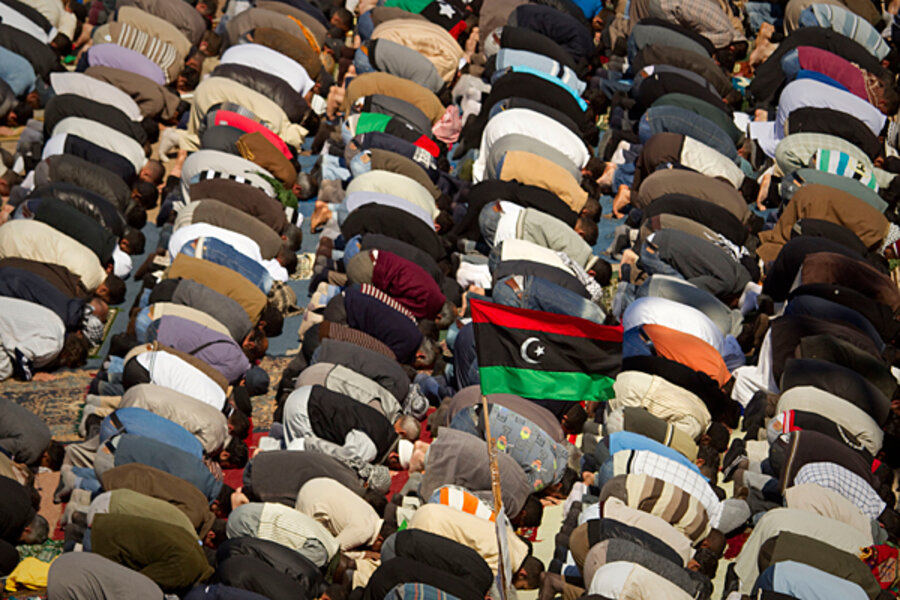Libya test for NATO starts at Ajdabiya
Loading...
| Benghazi, Libya
Libya’s uprising and the eastern enclaves that wrenched themselves free of Muammar Qaddafi’s rule in February may have been saved by international action six days ago.
Yet many Libyan cities remain under siege. The western town of Misurata, ringed by Mr. Qaddafi’s tanks and ground forces, has lost more than 100 residents in the past week, according to the hospital there. Other towns in the west where residents rose up against Qaddafi’s 41-year reign remain gripped by fear.
Now, in Ajdabiya, the first real test is unfolding of whether Libya’s rebels can gain ground under a cloak of international air support.
The town 90 miles west of Benghazi, the rebel capital, has been without electricity for almost two weeks, following a fierce battle between lightly armed rebels and Qaddafi’s better-trained and equipped forces. Qaddafi's troops had Ajdabiya surrounded this time a week ago.
Since then, French and British warplanes have repeatedly hit Qaddafi’s tanks, missile launchers, and resupply trucks on the desert roads around the city, allowing the rebel militia and some of the roughly 1,000 trained soldiers, which rebel leaders claim they have under their command, to creep within about five miles of the town.
French and British bombardment
Overnight Thursday, British Tornadoes fired Brimstone missiles at the remaining Qaddafi forces around the city. UK Defense Secretary Liam Fox said the missiles targeted “Libyan armored vehicles, which were threatening the civilian population of Ajdabiya.”
That focus on protecting the “civilian population” is to remain in compliance of UN Security Council Resolution 1973, which does not authorize overt support for the rebellion.
But in Benghazi and among the rebel militia around Ajdabiya, there’s an insistence that foreign air support has made retaking the town a near certainty. “We expect Ajdabiya will be liberated today or tomorrow," Mustafa Gheriani, a spokesman for the rebellion, told reporters today.
Ajdabiya, home to about 100,000, is perched on the edge of a 300-mile stretch of lightly populated desert that’s bounded in the west by Sirte, Qaddafi’s hometown and a hotbed of support for Libya’s self-styled “king of kings.”
Advancing on Sirte appears to be orders of magnitude more difficult than ousting Qaddafi’s forces from Ajdabiya, where they’ve been almost entirely without outside resupply or reinforcements since French warplane destroyed dozens of the regimes vehicles near the city last Saturday.
Building a rebel army
Rebel leaders say they’re seeking to build a proper army from the ground up that will slowly squeeze Qaddafi from the inside while financial sanctions start to bite from the outside.
“We know the international community isn’t going to give us a no-fly zone forever,” says Ahmed el-Gallal, a businessman who now acts as an adviser to the rebel government here. “This is all so new for us, we just need time.”
Fathi Terbil, a human rights lawyer whose arrest in February was a catalyst for the initial demonstrations and is now a member of the rebel government in Benghazi, says Qaddafi’s fighters are clustered around two traffic circles on the outskirts of Ajdabiya, and want to surrender, but are afraid of reprisals.
“What they want is for a trained army unit to come forward and oversee the surrender,” he says. “They’re afraid they’ll be killed if they surrender to the youths … these are the people whose family’s they’ve been killing, you have to remember.”
But as of Friday morning in Libya, Qaddafi’s forces continued to hold out. Reuters reported that rebel commanders at the front said surrender talks have been broken off.
Fighting continues
By mid-afternoon it appeared that heavy artillery was being used in the middle of the city once more, and witnesses said they saw multiple ambulances carrying wounded and dead fighters back east.
International support for the now NATO-led mission over Libya has been shored up in the past few days. The United Arab Emirates said today it would send F-16s and French-built Mirage fighters to enforce a no-fly zone.
But maintaining international support indefinitely is far from a given. Many of the backers of the no-fly zone are less comfortable with what some are describing as the “no-drive” zone against Qaddafi’s military units on the roads.
Though the intervention prevented Benghazi from being overrun and saved local rebel leaders from what they said would be massive reprisals, the air cover could also lead to a prolonged stalemate that could extend Libya’s conflict.
Mr. Terbil, who chairs the provisional government's youth committee, says the Libyan opposition's regular army is trying to extend command and control over the youth militias that have been in the forefront of the fighting so far, but that it hasn’t been an easy task.
He says the youths are skeptical of military officers like Abdel Fateh Younes, who may have defected but who served Qaddafi for decades and only jumped to the revolution when it looked like it had a chance of winning.
“Our fighters aren’t organized military units, they’re not organized religious units, they’re just people who showed up,” he says. “We’re trying to make it into something more formal, but it’s not easy. We’re trying to bring structure to something that’s just been organized on passion so far.”





